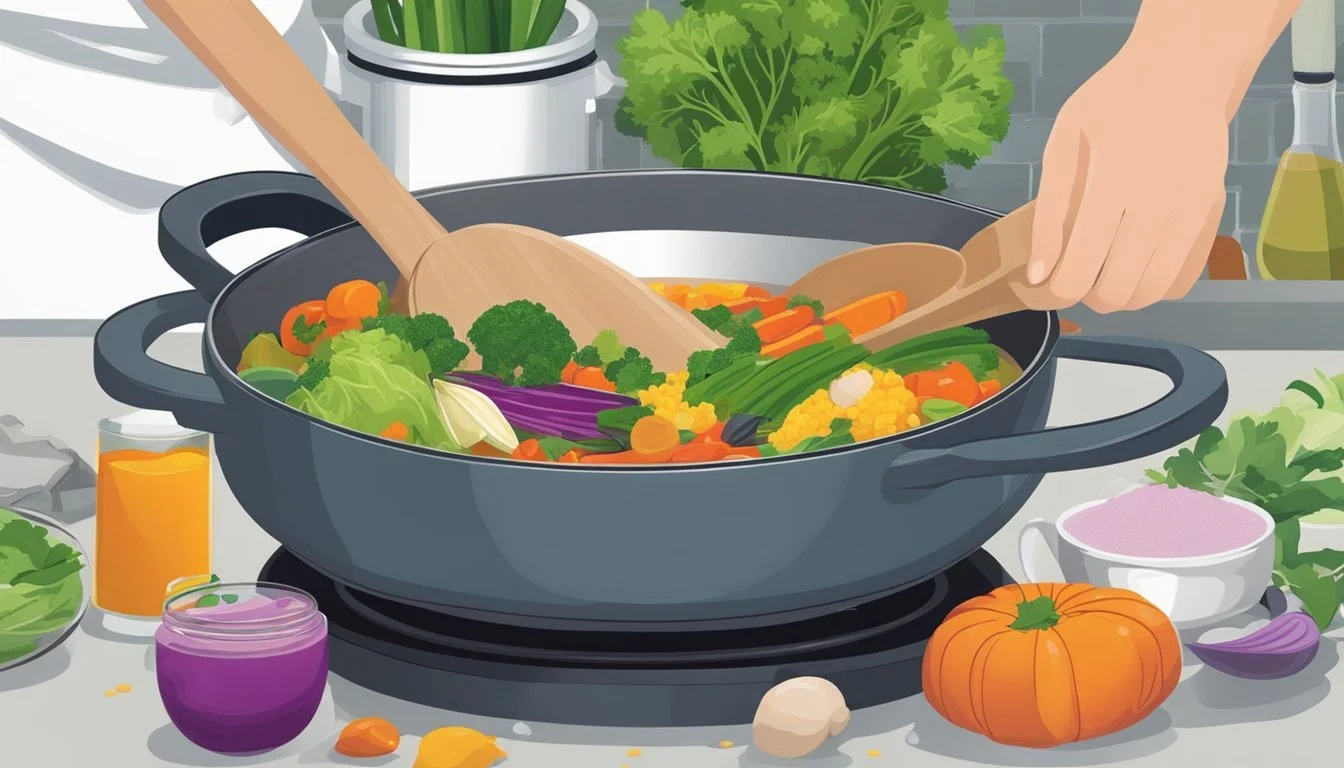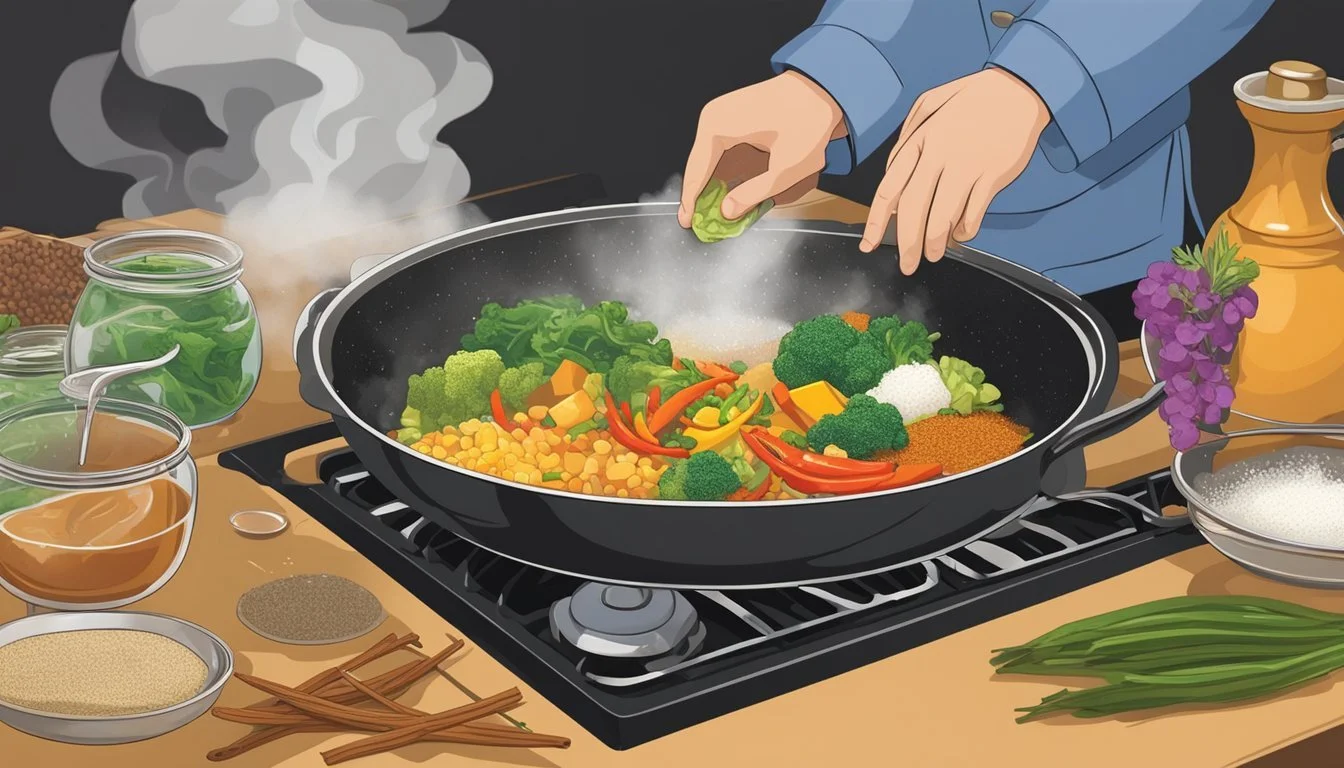Swicy Cooking Techniques
Unveiling Secrets to Flavor Harmony
Swicy cooking is an art form that masters the intricate balance of sweet and spicy flavors, offering a depth of taste that can elevate a dish from ordinary to extraordinary. This technique relies on the skillful layering of ingredients to achieve a harmonious flavor profile that tantalizes the taste buds without overwhelming them. The term 'swicy' itself is a portmanteau that blends the words 'sweet' and 'spicy,' indicating a fusion that has become increasingly popular in contemporary cuisine.
Chefs and home cooks alike are embracing the swicy trend, capitalizing on the dynamic range it brings to their dishes. The key to perfecting this cooking style lies in the careful selection of spices and sweeteners, adjusting their ratios to complement the primary ingredients of a recipe. By using this approach, a dish can gain complexity and become more engaging, providing an experience that keeps diners coming back for more.
Understanding Flavor Profiles
In the pursuit of culinary excellence, understanding and balancing flavor profiles are key. This section delves into how flavors interact with the palate and the fundamental components that make a dish memorable.
The Science of Taste
The human tongue is home to taste buds that detect the basic tastes: sweet, sour, salty, bitter, and umami. These receptor cells send signals to the brain to interpret flavor. The science of taste is intricate, involving not just the tongue but also the olfactory receptors, contributing to the perception of flavors through aromas.
Primary Flavor Components
Sweet: Typically associated with sugars and signifies energy-rich foods.
Sour: Linked to acidic compounds; sourness can add freshness and lift to dishes.
Salty: Sodium chloride is the primary source, enhancing and balancing flavors.
Bitter: Naturally present in foods like dark chocolate and coffee; it can counterbalance sweetness or richness.
Umami: Known as the savory taste, often attributed to glutamates and nucleotides, prevalent in foods like mushrooms and aged cheeses.
Taste Common Sources Sweet Sugars, Fruits Sour Citrus, Vinegar Salty Salt, Seafood Bitter Bitter Greens, Cocoa Umami Soy Sauce, Tomatoes
Flavor Balance and Complexity
A well-crafted flavor profile takes into account the harmony between the primary flavors. Chefs strive for a balanced palate where no single taste overpowers the others, unless intentionally desired for effect. Understanding the complexities of how these flavors interact is essential for crafting a tasting experience that is satisfying and intriguing. Balancing flavors involves a thoughtful addition and subtraction of ingredients to achieve the desired profile.
Ingredients and Their Roles
In Swicy cooking, each ingredient serves a specific purpose to strike a harmonious balance between sweet, sour, salty, umami, and bitter tastes. The following is a breakdown of these ingredients and their roles in creating perfectly balanced dishes.
Sweetening Agents
Sugar, honey, and maple syrup serve as sweetening agents. They counteract bitterness and enhance the natural flavors of other ingredients. While sugar adds a clean, straightforward sweet taste, honey provides a rich, floral sweetness, and maple syrup imparts a unique, earthy sweetness.
Sugar: Adds a simple sweetness, balances sourness.
Honey: Offers a complex, floral sweetness, good for glazes.
Maple Syrup: Delivers a woody, caramel-like sweetness, pairs well with autumnal dishes.
Sour and Acidic Elements
Citrus, including lemon juice, and vinegar are key to adding a bright, zesty note to dishes. These elements can lighten a dish's heavy flavors and provide a refreshing contrast to sweetness and richness.
Citrus: Examples include lemon, lime, and orange juice, which introduces a vibrant tanginess.
Vinegar: Varieties like balsamic, red wine, and apple cider vinegar add both zest and depth.
Salt and Salty Foods
Salt is critical for enhancing flavors and reducing perceived bitterness. Soy sauce offers a combination of saltiness with additional umami characteristics. Salty ingredients can elevate a dish by contributing to the complexity of its flavor profile.
Salt: Amplifies existing flavors, tempers bitterness.
Soy Sauce: Provides saltiness along with a savory depth.
Umami-Rich Ingredients
Umami ingredients, such as mushrooms and cheese, are essential for adding a savory depth that complements the other taste aspects. They bring a meaty richness to dishes without the need for actual meat and can round out the overall flavor profile.
Mushrooms: Impart a deep, earthy umami presence.
Cheese: Different varieties lend a range of savory notes from nutty to pungent.
Bitter and Contrast Providers
Bitterness is an important, though often underrated, flavor that can give dishes depth and complexity. Ingredients like coffee and dark chocolate add a sophisticated edge that can balance the sweetness and richness of a dish.
Coffee: A potent bittering agent that can be used in rubs and stews.
Dark Chocolate: Introduces a rich bitterness, works well in mole sauces.
Cooking Techniques That Enhance Flavor
Masterful cooking relies not only on the quality of ingredients but also on the techniques used to bring out their best flavors. Below are key methods chefs employ to amplify taste and ensure a memorable dining experience.
Heat Application
High-heat cooking techniques, such as grilling, broiling, and pan-searing, are fundamental in the development of rich flavors. They create a crust on the surface of meats through the Maillard reaction, a chemical process that transforms proteins and sugars, enhancing taste and aroma. Conversely, low-heat cooking methods, like simmering or baking, gently develop flavors over time and are ideal for tenderizing meat and fusing flavors in stews and sauces.
High Heat:
Best for: Meats, root vegetables
Outcome: Rich, caramelized crust; intensified taste
Low Heat:
Best for: Slow-cooked stews, delicate fish
Outcome: Depth of flavor; tender textures
Textural Contrast
Textural contrast can have a significant impact on a dish's appeal and flavor perception. A cook may combine elements like crunchy toppings or crispy garnishes with creamy or soft components to create a multi-sensory experience. This not only adds variety but also heightens the overall flavor profile of the dish. For instance, the addition of toasted nuts or seeds can introduce a pleasing crunch that contrasts with a smooth puree.
Examples:
Crunchy: Toasted nuts, croutons
Creamy: Mashed potatoes, soft cheeses
Marinating and Seasoning
Marinating combines herbs, spices, and acidic components to imbue proteins with complex layers of flavor before cooking. This process often makes use of oils and vinegars, which help in transferring flavors and tenderizing the meat. Seasoning, strategically done before, during, and after the cooking process, builds and adjusts flavor profiles. Even a simple act of rubbing salt on a pork chop before refrigeration can draw out moisture and concentrate flavors, as well as improve texture.
Marinating:
Ingredients: Acids (vinegar, citrus juice), oils, spices, herbs
Benefits: Enhances flavor; tenderizes proteins
Seasoning:
When to season: Prior to cooking; adjusting during cooking; finishing after cooking
Strategies: Salt rubs, fresh herbs, spice mixes
Each technique plays a critical role in the cook's toolbox, enabling them to present dishes that resonate with depth, aroma, and a harmonious balance of flavors.
Balancing Flavors in Practice
Achieving the perfect flavor balance requires understanding how to make real-time adjustments during cooking and knowing which ingredients create harmony within a dish.
Adjusting Flavors While Cooking
In the heat of the kitchen, chefs must often make rapid adjustments to their dishes to maintain flavor balance. To start, they might add a pinch of salt to enhance sweetness or reduce bitterness. Conversely, a dash of sugar can counteract overly salty dishes. Incremental adjustments are key—they allow a chef to taste and tweak without overwhelming the dish's existing flavors.
Sweet: Sugar, Honey
Salty: Salt, Soy sauce
Sour: Vinegar, Citrus juice
Bitter: Kale, Dandelion greens
Umami: Mushrooms, Parmesan cheese
By constantly tasting and adjusting, chefs achieve the perfect balance that caters to the palate.
Creating Well-Rounded Dishes
A well-rounded dish provides an all-encompassing taste experience, often leaving diners satisfied and impressed. To create such a dish, chefs layer flavors using a variety of ingredients. They counterbalance intense flavors, like the bitterness of dark chocolate, with sweet or creamy elements. Protein often provides a canvas for these flavors, absorbing and complementing the dish's seasoning.
Utilizing Fat and Acidity
Fat and acidity are two pivotal elements in the balancing act:
Fat: It is essential for carrying flavors and creating a satisfying mouthfeel. Ingredients like butter and olive oil can mellow sharp flavors or round out the edges of a dish. A slice of avocado in a salad, for example, can add smoothness that complements the sharper notes of dressing.
Fatty Foods Usage Butter Adds richness, mellows spiciness Olive oil Carries flavors, adds silkiness Cheese Balances acidity, adds creaminess
Acidity: This adds brightness and can cut through the heaviness of fatty foods. A squeeze of lemon juice or a splash of vinegar not only injects zing but can also highlight the core flavors of the dish.
Acidic Ingredients Usage Lemon juice Brightens flavors, cuts through fat Vinegar Adds sharpness, balances sweet flavors
Chefs blend these components with precision to forge a cohesive, delightful taste profile.
Flavor Pairings and Combinations
This section explores the art of combining flavors to achieve the perfect balance in culinary creations, focusing on established pairings, unique blendings, and insights from various global cuisines.
Classic Pairings
Classic flavor pairings have stood the test of time, creating harmonious and palatable experiences. Examples include:
Tomato and basil, where the acidity of the tomato contrasts beautifully with the sweet and peppery notes of basil.
Chocolate and mint, a coupling that offers the richness of chocolate with the refreshing coolness of mint.
Peanut butter and jelly, where the creaminess of peanut butter meets the fruitiness and sweet flavors of jelly.
These pairings rely on a delicate balance of simplicity and complexity, allowing each ingredient to complement the other without overpowering.
Innovative Combinations
Innovative combinations often emerge from the idea of pushing boundaries and creating unexpected contrasts. Some novel pairings include:
Spicy and sweet, such as combining chili with chocolate, elevates the heat with the complexity of cocoa and sweetness.
Sour cream and caviar, with the tartness of sour cream setting off the saltiness of the caviar.
Adding coffee to meat marinades, which introduces bitterness that heightens the savory flavors of the meat.
Experimentation is key, and these innovative pairings often result in complex flavor profiles that surprise and delight the palate.
Cultural Cuisines Insights
Different cuisines offer a wealth of knowledge regarding pairings and combinations. For example:
In Mexican cuisine, the combination of lime and cilantro provides a zesty, fresh lift to dishes.
Japanese dishes often employ the pairing of soy sauce and wasabi, where the umami of soy sauce is matched with the pungency of wasabi.
Italian cooking showcases the affinity between olive oil and garlic, creating a robust base for many dishes.
These insights demonstrate how regional ingredients and traditional wisdom shape the unique character of each cuisine's flavor combinations.
Advanced Tips and Techniques
In mastering the art of swicy cooking, chefs employ advanced techniques to elevate the sensory experience of their dishes. Precise layering of flavors and leveraging the role of smell are essential, as is the chef's ability to make intuitive, expert adjustments throughout the cooking process.
Layering Flavors
Creating dishes with depth and complexity involves intentional layering of flavors. Chefs achieve this by adding ingredients at different times during the cooking process, ensuring that each component contributes its unique taste profile without overwhelming others. The key lies in balancing the sweet, salty, sour, bitter, and umami elements to complement the inherent spiciness of a dish. For example, blooming spices—gently heating them in oil or dry heat—releases their volatile oils, which builds a foundation of aroma and taste.
Start with a base layer: Begin with onions, garlic, or aromatic vegetables.
Introduce main flavors: Add your primary spices like cumin or cardamom pods.
Finish with fresh accents: Herbs or citrus zests introduced at the end preserve their vibrancy.
The Role of Smell in Tasting
A chef understands that smell significantly impacts the tasting experience. Aromatic compounds released during cooking create anticipation and play a crucial role in the perception of flavor. Techniques such as chaunk, where spices are heated until fragrant, can make a dish inviting and flavorful before it even touches the palate. Incorporating techniques that enhance a dish's aroma can dramatically improve its overall taste perception.
Chaunk: Briefly frying spices to activate aroma.
High-heat techniques: Searing meats to develop complex aromas through the Maillard reaction.
Expert Adjustments and Intuition
The best chefs exhibit not only technical knowledge but also an intuitive sense in their cooking. They continually taste and adjust seasonings to strike the perfect balance, trusting their palate and experience. This skill allows them to tailor dishes to reach their full potential, often making swift in-the-moment alterations.
Salt: Judges its application carefully, sometimes in pinches, to brighten and deepen flavors.
Acid: Adds acidity in subtle increments to cut through richness and introduce brightness.
An expert chef's intuition may prompt them to deviate from a recipe, drawing upon their knowledge of how ingredients interact with one another. This refined sense often leads to inventive and remarkable results, creating a seamless and enjoyable tasting experience.
Frequently Asked Questions
This section answers common inquiries, offers guidance on ingredient substitutions, and provides solutions for when a dish doesn't taste quite right. Encompassing a range of topics, these FAQs serve as a valuable resource for any cook looking to perfect the balance of sweet and spicy—Swicy—flavors.
Common Cooking Queries
When endeavoring to harness the swicy flavor profile in cooking, chefs often encounter a set of typical questions:
How do I know if I've achieved the right swicy balance? Trust one's palate. A perfect swicy dish should present an initial sweetness that gradually transitions to a subtle heat.
Can swicy flavors work in any type of dish? Swicy flavors are versatile and can be incorporated into various dishes, ranging from appetizers to main courses and even some desserts.
Ingredient Substitutions
In the event that specific ingredients are missing or a lesser potency is preferred, the following substitutions can be useful:
Sweet: Missing honey? Maple syrup or agave nectar can be used as a substitute for sweeteners in a swicy dish.
Spicy: If fresh chili is too potent, chili flakes or a pinch of cayenne pepper can achieve a similar effect with a more controlled heat level.
Troubleshooting Flavor Issues
Should a swicy dish not come out as intended, one can perform the following troubleshooting techniques:
Too Sweet: Add a touch of acidity with lemon juice or vinegar to cut through the sweetness.
Overwhelmingly Spicy: Introduce a dairy product such as yogurt or coconut milk to mitigate the heat without overshadowing the sweet profile.
Conclusion
The art of 'Swicy' cooking is a testament to the culinary creativity and the evolving tastes of food enthusiasts. The balanced juxtaposition of sweetness and spiciness, when done correctly, can accentuate flavors, turning a simple meal into an extraordinary experience.
Chefs and home cooks alike aim for harmony on the palate. By integrating sweet elements with spicy, there is potential to stimulate a full spectrum of taste receptors. It isn't simply about heat, but the depth and layers of flavor. The endorphin release associated with spicy foods, paired with the calming effect of sweet flavors, makes for not just a meal, but a sensatory journey.
Trying these techniques at home requires attention to detail and a willingness to experiment. Using honey to counteract the heat of a jalapeño, or a sweet glaze to complement a spice-rubbed protein, achieves a 'swicy' flavor. Not all sweet and spicy combinations will work universally; finding the right balance is key.
Experimentation: Start with known pairings and gradually adjust ratios.
Taste as you cook: Personal preference plays a significant role in finalizing the flavor balance.
Consider the ingredients: Some spices may have an intrinsic sweetness which can be used to the cook's advantage.
In summary, mastering the balance of flavors is the cornerstone of 'Swicy' cooking. The trend's rise in popularity speaks to its broad appeal and the inviting challenge it presents for both professional chefs and home cooks. By blending the correct proportions of sweet with spicy, one can deliver dishes that are rich, satisfying, and on the cutting edge of culinary trends.





